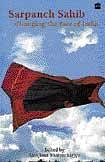
What do Deepanjali from Kalahandi, Chinapappa from Pachinakapalli, Sunita Adivasi from Tighra, Maya Bhakhuni from Boonga, Maloti Gowalla from Chamong, Veena Devi from Nawada, Kenchamma from Tarikere — separated from each other by thousands of kilometers — have in common? Possibly even unaware of each other’s existence, these women are nevertheless bonded by the revolution that swept through rural India in the guise of the 73rd Constitutional Amendment.
At a time when there is an animated debate on the 33 percent reservation for women in the lower house of the Indian Parliament, this book could not have been timelier. Even as arguments against reservations are eloquently voiced, and even while conceding that the bill in its current forms need major surgery, there is no doubt that women’s reservation will play a positive role. And Sarpanch Sahib proves well the empowerment that reservations can and have conferred on large sections of society — the critical mass.
As Manjima Bhattacharya writes in the introductory note: “The history of women in politics in South Asia is beset with contradictions. Despite having strong women as prime ministers and presidents, it hasn’t necessarily translated into any real or radical change in the representation of women and their concerns in mainstream politics.”
India has a mere eight percent women in parliament. At the grass-roots however, the 73rd constitutional amendment mandated that one third of all panchayat seats be reserved for women and this had sweeping results — empowering three million women across the country. Even critics who would argue that many of these panchayat members were no more than rubber stamps for their husbands, fathers or brothers (and it is futile to deny this), the very act of reservation resulted in change and empowerment by default.
It was to make women’s participation in panchayati raj more meaningful that the Hunger Project, India, organised trainings for women in rural areas across 14 states, to encourage them “to participate in the political process, equip them with the knowledge required to perform their roles as panchayat leaders efficiently.” Thousands of women pass through these trainings and each of their stories is unique. Sarpanch Sahib is an endeavour to document some of these unique stories. Seven writers travelled from their cities to visit one elected woman panchayat president each, and “helped her tell her story to the world.”
So we know how Deepanjali, a young educated tribal woman from Kalahandi was asked to stand for elections for the reserved category in her village because the adivasi leaders were keen to field fresh young representatives and a young unmarried woman would be easy to manipulate. Chinapappa, a Dalit woman from Pachikanappalli, has to first cook for the entire family, clean the house, get the children ready for school and then go to attend panchayat meetings.
Sunita, an adivasi woman from Tighra village tells us that like other women of her village, she too could not say anything and went around with her pall pulled in front of her face. But after she became sarpanch, she learned to speak up and installed handpumps, paved roads, and had a well dug for when the pumps run dry. Maya Bhakuni, the first gram pradhan from village Boonga lost her seat by 50 votes to another candidate who won by “bribing villagers and offering them unlimited free liquor.” Maloti of Titbar anchalik panchayat in Jorhat recalls that she “thought how difficult it would be for my son to walk or cycle down that (bad) road to school.” So she got the road paved.
Veena Devi of Nawada district, the only woman among several men, was afraid to speak up, but learnt about her duties as a mukhiya through “part instinct, part common sense and partly the result of the intervention of the Hunger Project.” Kenchamma of Chikmagalur district felt “guilty and embarrassed. No good clothes, going and sitting everyday, and coming back without saying a word....” However, with help from the Hunger Project she learnt enough to construct a Panchayat Bhavan, and mobilized women to close down arrack shops in the village.
Sarpanch Sahib is an important document testifying to what reservations are capable of achieving, as are women when they have a level playing field. The only glitch is the monotone of the narratives. An exciting project like this could have been more creatively engaged in. A few chapters into the book and the script becomes predictable. That however does not detract from the book’s main merit — the documentation of the silent revolution sweeping through rural India, the devolution of power at the very grass-roots, and the deepening of our democracy.
